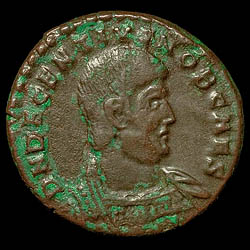
Conditions of Preservation
Other than wear, which is addressed by the currently popular grading standards, many things could happen to an ancient coin on its travels into our collections. Some of these things are positive. Burial under the right conditions sometimes produced a controlled surface corrosion that collectors consider beautiful: the patina. Most, however, of the situations discussed below describe faults that coins show in reaction to the stresses of burial in the earth and handling by people both ancient and modern. It is quite possible that these factors could continue to change with time. Careful cleaning can greatly improve the appearance of some coins. Amateur efforts at cleaning can reduce the value of a coin substantially. Brightly cleaned surfaces can retone attractively but corrosion can eat away coins stored improperly. Coins are hard to improve and easy to ruin while in the hands of modern collectors.
 |
aVF Darkly toned Julia Maesa denarius Silver coins can take on a dark tone (natural or chemically induced) that collectors tend to prefer over bright silver. VF Rainbow toning |
 |
 |
EF Fully Cleaned Septimius Severus denarius SPQR rx. Emesa mint Many recently found ancient coins ("hoard material") have fully clean, smooth, shiny surfaces. ALL ANCIENT COINS HAVE BEEN CLEANED! (The ones with an inch of dirt on the surface used to have two inches.) Some are severely damaged in cleaning; some are done very professionally. |
 |
 |
VF Green Patina Septimius Severus sestertius This coin has a hard even (but slightly multicolored and textured) surface corrosion or patina. Patinas can be found in a range of colors. Green is common and popular. F Smoothed Green Patina |
 |
 |
VF Olive Patina Julia Domna as Green patinas come in a range of shades from light olive to almost black. F Black Patina |
 |
 |
F Red Patina Tiberius as altar rx. Red patina is often seen as spots but sometimes covers enough of the coin to be classified separately. gF Blue Patina |
 |
 |
VF Earthen/Sand Patina Maximianus post reform radiate Patina can be combined with hard soil deposits that produce an attractive contrast. This is prefered to patina worn away from the high points. aVF Contrasting surfaces |
 |
 |
aVF Thick Patina Carausius antoninianus Felicitas rx. Too much of a good thing can cause detail to be lost under an overly thick surface coating.
F Chippy Patina |
 |
 |
VF Uneven, patchy patina Decentius centenionalis Partial, uneven patina can look worse than no patina at all! EF Patchy silver wash |
 |
 |
VF Fingerprint Septimius Severus denarius Mars rx. Ridges at the upper right of this coin could be the result of etching by an ancient fingerprint over the centuries or handing by a modern coin cleaner with strong chemicals on his hands. VF Porous |
 |
 |
F Surface pitting Clodius Albinus sestertius Minor pitting or heavily porous surfaces obscure detail on many bronze coins. G Patchy, rough surfaces |
 |
 |
F Severe pitting Caligula as Heavy pitting leaves major areas of erosion and severe defacement. The coin is ugly despite having considerable detail. F Eroded and tooled |
 |
 |
F Crystalization Corinth trihemiobol Over the millenia, many silver coins show formation of a crystaline pattern in the metal. F Lamination |
 |
 |
VG Unnaturally polished Galba sestertius This coin was obviously polished and possibly tooled to restore lost detail. If a coin is tooled, details restored must belong to the original coin.
VG FRAUDULENTLY Tooled |
 |
 |
F Graffiti Pharsalos, Thessaly drachm Scratches (here K) on some coins appear to be have made intentionally.
VG Holes |
 |
 |
G Holed and cracked Septimius Severus denarius Legion XXII PRI rx. The example has a bad crack near the hole and is in danger of breaking.
F Chip |
 |
 |
aVF Broken edge Commodus AE 28 Flaviopolis, Cilicia, Isis-Serapis rx The ragged edge on this coin may result from bad flan preparation or later damage. The scar is patinated over so the damage is ancient. F Scratched |
 |
 |
F Intentional damage Septimius Severus/Julia Domna AE35 Stratonicaea, Caria A small countermark (Geta?) was removed from the coin in antiquity. F Halved coin |
 |
 |
VG Countermark F Nero Claudius Drusus sestertius NCAPR in the countermark was stamped into this coin under Nero to certify the coin as valid. Stamping frequently left a flat spot on the opposite side of the coin. Dealers often state a separate grade for a countermark on a more worn coin. VF Test Cut |
 |
 |
VF Test Cut Fourree Athens tetradrachm owl rx. However, this cut revealed the coin was silver plated with a copper core or fourree. F Worn Fourree |
 |
 |
F Surface deposits Julia Domna denarius Moneta rx. Spots of metal from other coins or chemicals in soil can form raised lumps on surfaces. F Copper deposits |
 |
 |
VF Clipped Charles I halfcrown Silver coin edges were often trimmed by persons building a supply of the metal. The illegal practice was common and many coins are missing legends. This reduces the coin's value. F Ex Jewelry |
 |
These are by no means all of the factors to consider when grading ancient coins. Please let me know what conditions I should add to this list. It is hoped that these examples will make you think about what makes a coin appealing, attractive or desirable and cause you to lighten up a bit when criticising dealers who have to grade using the woefully inadequate current system.
Back to Grading Menu Page
Back to Standard Grading Page
Go to Conditions of Manufacture Page
Back to Main Page 
(c) 1997 -2011Doug Smith